
Public Art Workgroup
- 0
- 0
Art and Beautification
The goal of public art is to promote a diverse and stimulating cultural environment to enrich the lives of residents, visitors, and employees.
If you are interested in getting involved, please contact us at (650) 363-1800 or CommunityAffairs@smcgov.org
Middlefield Mural
Mural at 3090 Middlefield Road
A Call for Artists was released in December 2017 inviting all artists to submit mural designs for the proposed mural project and approximately twenty artists submitted designs. The North Fair Oaks Public Art Workgroup reviewed the submissions that met the criteria of the call for artists and the top three candidates based on their feedback were presented to the North Fair Oaks Community Council. The council reviewed the top three submissions and gave their feedback to select the top two for the Board of Supervisors / County Manager's Office to review. The selected artist, Jose Castro, is a North Fair Oaks native who has lived there his whole life. Jose has created a vibrant, colorful, and detailed mural design that depicts the cultural diversity and the history of North Fair Oaks. Work on the mural began in June of 2018 and is expected to run until November of 2018.

#MiddlefieldMural
Am Somebody/Soy Alguien Mural
Mural at 2890 Fair Oaks Avenue
A Call for Artists was released on September 1, 2016, inviting all artists to submit mural designs for the proposed mural project, although extra consideration was given to local artists. Installation of the artwork begun in early 2017.
The selected artist, Nico Berry, a resident of the City of San Francisco, submitted one design. 15 designs in total were considered by the Public Art Workgroup based on the following criteria:
- Artistic excellence, innovation, and originality
- Documented potential and experience to complete the project successfully and within the required timeframe
- Level of community theme and involvement (although not required)
- Extra consideration was given to artists who live or work in North Fair Oaks, and/ or San Mateo County
Based on the majority vote of the Public Art Workgroup and the approval of the North Fair Oaks Community Council, the following design was selected and completed for the mural at 2890 Fair Oaks Avenue.
Nico Berry invited the students from Fair Oaks Community School to help paint the mural.
Students involvement continued with fifth-graders participating in an essay contest where they expressed what the mural meant to them and what it meant to the community. Four essays were chosen to be read during the March 3, 2017, Mural Celebration in front of County Staff, School Board Members, Public Art Workgroup Members, Fair Oaks Students, and Staff, and North Fair Oaks community residents.
Entry Sign Sculptures
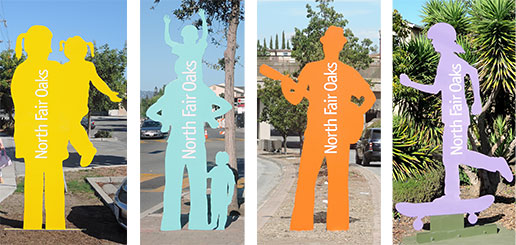
(Images will be updated in the near future)
- Yellow Sign located on Middlefield Road in front of the Fair Oaks Library
- Blue Sign Located at the Intersection of Middlefield Road & 8th Avenue
- Orange Sign Located on 5th Avenue at Waverly Avenue
- Purple Sign located at the corner of 5th Avenue and Fair Oaks Avenue
More info: About the Project
Artist: Kent Manske
Utility Boxes
(Image will be updated)
5th Avenue at Middlefield Road
Artist: Shayne Oseguera
Middlefield Road at 8th Avenue
Artist: Shayne Oseguera
5th Avenue at Semicircular Road
Artist: Shayne Oseguera
5th Avenue at Waverly Avenue
Artist: Nancy Simenc
Public Murals on Middlefield Road
Fair Oaks Health Center, 2710 Middlefield Road, Redwood City, CA 94063
Artist: Precita Eyes Muralists
Fair Oaks Community Center, 2600 Middlefield Road, Redwood City, CA 94063
Artist: Unknown
Fair Oaks Community Center, 2600 Middlefield Road, Redwood City, CA 94063
Artists: Unknown
Murals at Schools in North Fair Oaks
Murals at Fair Oaks Community School
Murals at Garfield Community School
Previous Events in North Fair Oaks
NFO Art Walk 2015
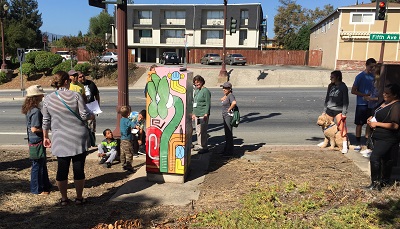
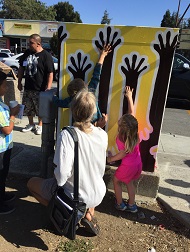
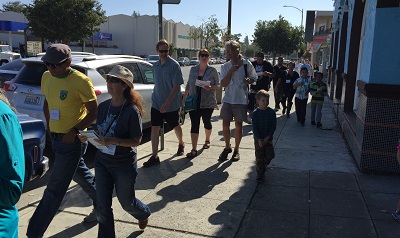
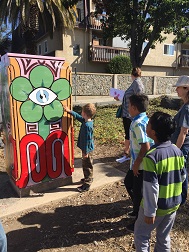
North Fair Oaks Community Festival 2015
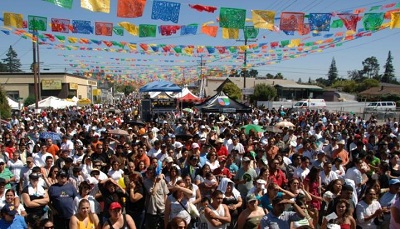
The North Fair Oaks Public Art Workgroup is an ad hoc group formed to implement the North Fair Oaks Community Plan. Specifically, they provide input and recommendations regarding public art to the North Fair Oaks Community Council and the County. The workgroup was created to represent the diverse views of the community and is composed of residents, members of the North Fair Oaks Community Council, and the San Mateo County Arts Commission. Some of the projects the workgroup has taken the lead on include community entrance signs, a call for local artists/graffiti abatement project, and a living wall.
How to become involved in NFO Art
1. Join the Workgroup
Join the North Fair Oaks Public Art Workgroup. We meet on the first Monday of every month at the Fair Oaks Health Center from 6:00pm-7:00 pm. Visit a North Fair Oaks Public Art Workgroup meeting and share your ideas.
2. Exhibit artwork at your business
We encourage local businesses to exhibit artwork. When you do, be sure to let us know so we can include your business on our "Art in NFO" list and "NFO Art Walk" map.
3. Have a mural painted on your building
Below you will find a practical guide to creating a mural in North Fair Oaks.
A Practical Guide to Creating a mural in North Fair Oaks
This guide assists artists, community organizations, businesses and property owners, and arts and heritage organizations by recommending best practices in mural production. This guide is only a guide. You are welcome to use it in conjunction with other resources and talents available to you. The County of San Mateo is not responsible for implementation of the below suggestions.
Why Create a Mural
The benefits of murals are plentiful, not only do they beautify and enhance the urban environment, they deter costly tagging, foster community partnerships, and pride, and can even boost the local economy. Above all, they're fun!
Definitions
Mural:
A large-scale artwork completed on a surface with the permission of the owner. Media may include paint, ceramic, wood, tile, and photography, etc.
Community Art:
Public participation and collaboration with professional artists in visual art, dance, music, theater, literary and/or media arts within a community context and venue.
Commemoration:
The act of honoring or perpetuating the memory of a person, persons, even, historical period or idea that has been deemed significant.
Sign:
If the primary intent of the work is to convey commercial information, it is a sign, not a mural.
Tagging:
A common type of graffiti is "tagging", which is the writing, painting or "bombing" of an identifiable symbolic character or "tag" that may or may not contain letters.
Public Walls:
A space that belongs to a public organization, i.e. municipal, provincial or federal government. Approval for the mural should be among the first steps undertaken in the planning process.
Private Walls:
A space that is owned and maintained by a private individual or enterprise. Approval for the mural should be among the first steps undertaken in the planning process.
Respect Considerations
- The theme of the mural should be respectful of the greater community
- The mural should complement and enhance the building and incorporate the architectural features of the building
- A mural should be appropriate within the context of the surrounding neighborhood
- The mural should be an original design
- Community input should be taken into consideration
- Murals should not contain text, graphics, or symbols which advertise or promote a business, product, or service; nor will the work promote a specific political candidate or party, religion or violence
Roles
Property Owner:
The property owner (be it private or municipal) provides the surface for the mural. It is the property owner's responsibility to be familiar with regulations and procedures prior to commissioning a mural.
Artist:
The artist is the communicator, demonstrating style and disseminating information. The mural artist creatively inserts culture into the urban environment. The artist can work alone or lead a community group in the development of a mural.
County of San Mateo:
The County is only involved if the mural is on public property. The County can provide guidance and help promote your activity and the finished mural.
Steps to Creating a Mural
Planning Phase
- Choose a site (see considerations for selecting a wall below). Consider your space requirements and be aware that routine maintenance activities such as sidewalk sweeping or snow removal may affect the mural and the wall it is on. Check with the City regarding encroachment agreements and any associated fees
- Determine the objectives and scope of the project. What is your goal? What is your vision? If you are the artist, it is helpful to create a mockup or maquette or your chosen design before going to step 3
- Get written permission from the property owner, be it a private owner or the municipal government. If it's a private owner, detail the terms with the owner (i.e. size, content restrictions, the method of attachment, budget, and responsibility for cleaning and future maintenance). If the proposed site is public property, you should present your idea to the municipality.
Implementation Phase
- Confirm scope, budget, and materials for project
- Ensure funding is in place & determine a pay schedule
- Create a timeline
- Assess conservation needs
- Ensure compliance with County by-laws and regulations
- Write and sign a contract with the property owner and/or artist
- Obtain liability insurance
- Purchase materials and arrange for equipment hire
- Decide which method will be used to install the image to the wall
- Engage the community (arrange for publicity and a launch or unveiling (an opening reception is common)
Installation Phase
- Document site before, during & after installation (photos)
- Prepare and clean the surface
- Create the mural being sure to use safety precautions
- Offer updates to the property owners and/or municipality
- Schedule an inspection of the final painted/installed mural
- Clean up
Evaluation / Completion Phase
- Final photographs should be taken and documented into an archive maintained by the County
- Maintenance requirements (e.g. paint colors) should be recorded
- The artist's contact info should be recorded and kept up-to-date
- Public launch of mural (press & community event)
- Inspect seasonally for maintenance needs
Choosing a site
The criteria you have set for the project, as well as the cooperation of the local community, business and municipality will all be factors in choosing a site.
The lifespan of a mural can be quite severely affected by the location. One of the major causes of damage to a mural is water. Ensure that there is no water seepage from roof or ground level. The condition of the chosen wall should be checked thoroughly before work begins. This may require an assessment from a professional conservator if it is a historical building. Before and after photographs should be taken. Prior to any work being undertaken, the area should be measured and any wall damages or potential obstructions (branches, troughs, etc.) recorded.
A decision to be made is whether to paint directly onto the wall or onto a panel that will then be placed a the site. One of the pros of working directly on site is community engagement with the project as they directly see the progress being made. However, it can be easier to have the mural painted onto panels offsite which when completed are mounted on the wall. The pros with this method are: ease of relocation and repair, ease for the artists who can work indoors and in any condition (day or night, rain or shine), and safety considerations (the artist will not need to be on a scaffold or near the public to work)
Preparing the site
The following information is provided for general information purposes only. A local paint store can provide professional suggestions.
Best types of walls
Brick, Plaster, Concrete, Sign Board
Best types of Surface Panels
Sealed exterior plywood that can be supported by a metal structure. It is very important that the edges be sealed. A visit to a local sign shop would be beneficial. DIBOND is a rubber core sandwiched by aluminum. This material comes in panels, and must be primed and top coated
Wall Preparation
Ensure that humidity levels and temperature are appropriate for installation of the materials. Clean the wall, as well as scrape and chip to establish a smooth surface before applying paint. Small cracks will not cause a problem and usually get filled with paints. However, long cracks leading to the ground surface can cause a water seepage problem. If you choose to parge the wall for a smoother surface, employ a professional.
If the surface is already painted, consider what kind of paint it is and its physical condition (the artist should realize that any surface that still has the previous coating on it will not be as permanent as one that has been complete stripped and freshly coated). If the paint is water based polymer most acrylic paints will adhere well to this. If it is a high gloss oil paint, then it must be removed for good adhesion. If existing paint is deteriorating it should be removed; however, even if it is intact it is recommended to thoroughly power wash to remove loose dirt and materials prior to painting. Coatings failure can be directly related to insufficient surface preparation.
Mold and mildew should be removed by scrubbing with a mixture of 1 part household bleach to 3 parts water. Be sure to wear protective gloves, goggles, and equipment for this task. After scrubbing with a brush, allow the solution to sit on the surface for ten minutes before thoroughly rinsing off with water.
Caution: never add ammonia to bleach
Cleaning Tips
- Use a solvent cleaner (powder) that removes oil
- Patch repairs with filler. Gel medium works well. If cracks are large enough to warrant filling in, inject a construction adhesive followed by hard foam stripping pressed into the adhesive. Do not apply a silicone sealer as these products are usually too slick to get proper adhesion of the paint
- Sandblasting is one option for smoothing out the surface area, but it will also allow water to seep into the surface, therefore it is not advised.
Safety Precautions
Make sure that the work site is safe for the public and that artists are familiar with required materials, protection techniques, and safety equipment.
Weather Considerations
Avoid painting in rain, snow, and fog as the moisture will affect the drying times and will reintroduce water back into the recently dried paint films. Allow proper drying/curing time between washing the surface and applying the isolation coat and varnish layer (if you are using one) as trapped moisture can hinder adhesion and cause clouding. Ideally, the temperature during application should be between 18 degrees Celsius (64 degrees Fahrenheit) and 24 degrees Celsius (75 degrees Fahrenheit). Higher temperatures will affect the evenness of the paint films, and lower temperatures will harm the film formation of all the coating.The absolute minimum temperature is 10 degrees Celsius (50 degrees Fahrenheit)
Primer
To determine the best primer for a specific surface, we suggest artists contact a local supplier of architectural coatings. Such companies have extensive experience with priming the broad spectrum of building supplies, and typically have specific primers for the surface the mural is to be painted on. Their recommendations will also take the environmental concerns of the area into account. We have found that architectural and maintenance paints are competitively priced, meaning that a product that costs more than a similar product will typically perform better as well.
Materials
When painting on brick, concrete, or other masonry surfaces, it is recommended to also use a Masonry Conditioner that can be purchased from a commercial coatings supplier.
Paint
Acrylics are some of the most durable and accessible paints for exterior application, used by many artists for painting murals due to their lightfastness and weather resistance. They also form an excellent bond to masonry or cementitious surfaces. Oil paints are a poor choice for painting on these surfaces since the alkalinity of concrete can destroy alkyd or oil products. Ethyl Silicate paints form an excellent and permanent bond with brick or concrete; however, this system can be time-consuming and costly, and good working knowledge of the system is required as well. Solvent-based enamels are a good choice for durability, but manufacturer's pigment considerations are usually not the same as with a high-quality artist's acrylic paint.
Protective Coatings
Never apply anything to the surface of your mural that cannot be taken off without damaging the mural. A good protective coating will preserve and protect the paint beneath it. All too often, coating media is applied that obscures, discolors, or deteriorates the paint.
Additional Materials
Scrapers, drop sheets, brushes/rollers, buckets, sponges, facemasks, gloves, ladder/scaffolding
What NOT to use
Artists should avoid the following commonly employed media as they may shorten the lifespan of the project:
- Acrylic varnish UV is reflected from the surface of the varnish, which gradually clouds the varnish, causing the mural to appear faded.
- Urethane, spar varnish, and damar varnish can only be removed using alcohol, Toluene, Xylene, or Acetone. These are destructive to acrylic paint and tend to discolor over time.
Identification
When the mural has been finished the artist(s) should sign their work. This could range from a simple painted signature to an interpretive label or plaque. Signage should include:
- Artist(s) name(s)
- Title of the work
- Date of the work
Conservation and Maintenance
Ideally, the person who is commissioning the piece should be responsible for its maintenance. The contract should clearly outline who is in charge of maintaining the work and who will provide funding for maintenance. One possibility is to put maintenance expenses into the initial budget. If the commissioner of the mural is to be left in charge, it is the artist's responsibility to update their contact information for future assistance. If the artist cannot be reached, the commissioner should be permitted to take action into his or her own hands.
Artistic Process
Comunity Arts Process for mural art Community art involves collaboration between a professional artist and a community, be it a neighborhood, marginalized group, cultural group, youth, or artists. This process involves the community in the artistic process whether through artist selection, project conceptualization, or actually having a hand in its creation.
Community Arts Project
An artist leads/facilitates a community in the conceptualization and creation of a mural. These types of projects are very good in breaking boundaries, team building, increasing creative capacity, and building ownership of a community space.
- Ensure that the artist chosen for these types of projects has experience with the community you have identified, is patient, flexible, can communicate clearly with others, can facilitate the creative process of a group (small or large), has team-building and motivational skills, and can negotiate within the team dynamics. An arts education background is an asset.
- Educational components around painting techniques, historical aspects of the community etc. are also a key component of this type of project.
- A project of this nature may take several weeks to months of planning before the actual mural production begins.
Commissioned Project
Commissioning an artist for the project promotes artistic excellence and usually involves a competition
- A professional artist is paid to conceptualize and create the work of art
- Once designs have been approved, the creation of the work can commence
- The community gets involved in the selection of the artist and should be consulted in the concepts and themes represented in the mural.
Direct Commission
A property owner may approach an artist or invite artists on his or her own or vice versa. At a minimum, the following should be considered:
- Prepare and have signed a contract that clarifies roles and responsibilities
- Require an artist resume and examples of recent work
Selecting an Artist
A "Call to Artists" reaches a varied and broader artist base and provides opportunities to all.
- A "call for muralists" should be posted wherever it is attainable to artists; consider your community newspapers to target a smaller community, or social media that artists reference
- Allow at least a month from the time you post the ad to the submission date.
Web-based "call for artist" services
Bay Area Art Grind
CAFE
Local Mural Artists
Morgan Bricca
Finding a Local Artist
San Mateo County Arts Commission
San Mateo County Arts Grant Program
Redwd City Parks and Arts Foundation
Planning Ahead for your Project
Budget
The budget is conditional on many things, including quality, size, and location.
Keep these key points in mind when putting a price on something:
- Artist fees
- Mural materials
- Wall preparation
- Installation (equipment & fees)
- Liability insurance. Consider timeframe of coverage from initial creation of mural to end of installation
- Provision for ongoing maintenance costs
- Publicity (may include a planned launch with an opening reception)
- Artist fees may include materials, installation, etc., or you may include these as separate line items
Artist Payment Schedule
The payment schedule should be clearly outlined in the contract. Most of the expenses will be incurred prior to the start of work. The artist should be given at least enough money to cover these costs.
- 40% upon signing the contract
- 30% during the Installation phase
- 20 % upon completion of the mural
- 10% after inspection
Contracts and Legal Issues
Contracts for mural should include the following:
- Outline roles and responsibilities of all parties involved. For example, who is responsible for installation, conservation, clean up, storage, and maintenance
- A description of the artwork, location, and anticipated lifespan
- A timeline outlining how long the project will take
- Payment Schedule
- Liability Insurance
- Ownership / Copyright
- Maintenance requirements and responsibility
- The artist moral and copyrights
Insurance
Multiple parties are involved when producing a mural. To protect these individuals, insurance should be obtained:
- If you are an artist you should obtain personal accident injury insurance
- If you are the organization or private business managing the project, you should have third party liability insurance
- If the work is commissioned by a community association
(If volunteer labor is used, a volunteer waiver form should be signed by all participants)
Helpful Links
How to Paint a Mural
http://www.wikihow.com/Paint-a-Mural
http://www.widewalls.ch/how-to-paint-mural-think-grid/
Ideas for Murals
Teaching Tolerance
Activate Activism: Classroom Project
http://www.tolerance.org/lesson/activate-activism-creating-our-mural-part-one
http://www.tolerance.org/lesson/activate-activism-creating-our-mural-part-two
http://www.tolerance.org/lesson/activate-activism-planning-our-mural
http://www.tolerance.org/lesson/activate-activism-planning-our-message
Making Murals, Making History
A Mural Making Guide for k-12 Teachers
http://www.kuidaosumi.com/murals/muralguide.html
Guides and Public Policy
Chicago Public Art Group
http://www.cpag.net/guide/2/2_pages/2_1.htm
http://www.cpag.net/guide/contact.htm
Aukland Council
http://www.aucklandcouncil.govt.nz/EN/newseventsculture/Arts/Documents/muralstoolkit.pdf
City of Albuquerque
https://www.cabq.gov/culturalservices/public-art/about-public-art
We invite you to comment and welcome your remarks. To keep the conversation germane and constructive, we reserve the right to remove content if it includes the following:
- Obscene Language
- Sexual content
- Personal attacks
- Defamatory remarks about an individual and/or organization
- Threats
- Commercial products/Services advertising
- Information not related to the topic

Would like to post a comment on this project?
Log in or register to post comments